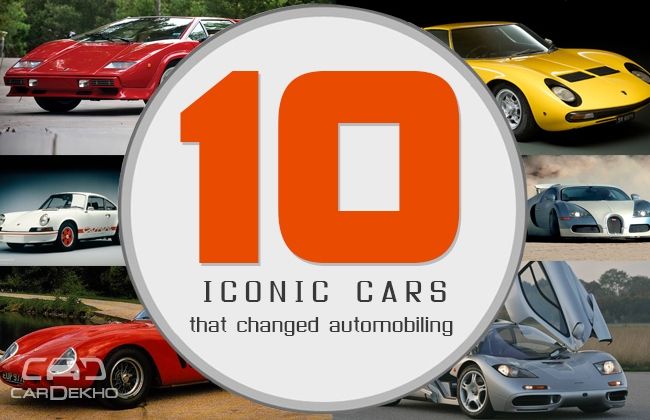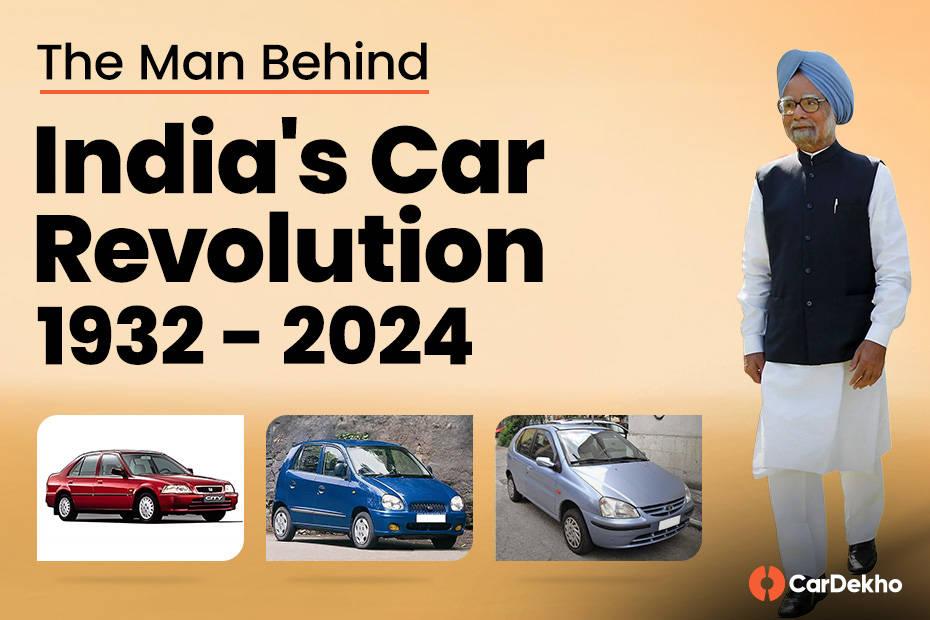10 iconic cars that changed the automobiling
Modified On Oct 20, 2015 03:07 PM By Firdaus
- Write a comment

Also Read: Top 10 Most Expensive Cars in the World
1. The Ferrari F40
The Ferrari F40 was the last car to be commissioned by Enzo Ferrari to celebrate 40 years of production at the Maranello factory. The F40 was known for its combination of dazzling looks, mind-numbing performance (back then) and the race car technology that it came with. Based on the lines of the 288 GTO Evoluziones, the Ferrari F40 took the concept of a powerful engine in a lightweight body to a whole new level; with a power-to-weight ratio of 400bhp per ton, it set new performance benchmarks. This car focused purely on driving and performance and hence was devoid of comforts such as carpets, stereo, sat-nav, central locking and even door handles!

Its 2936cc V8 twin turbo engine produced a power of 471 hp, known for its neck breaking acceleration and the tremendous g-forces accompanied with it. There was direct communication between the suspension and the steering making it feel even more alive. Only 1,311 Ferrari F40s were produced.
2. Lamborghini Countach

The story of how Lamborghini cars came into production is famous, and of all the cars produced by this iconic Italian marquee, one which adorned the walls of every car lover around the world was the Lamborghini Countach. The wedge shaped design, sharp edges, scissor doors, pop-up headlights and the NACA ducts made this car one of the most aggressive looking one of its time.
The Countach body was made using air-craft grade aluminium with a tubular space frame, which was extremely expensive to build, but was exceptionally strong and light weight. The first produced Countachs features a 4-litre engine, but later the displacement was hiked to 4.8 litres and then 5.2 litres. The car was rear wheel drive and in trademark Lamborghini style its engine was mounted longitudinally with a mid-engine configuration.
The Countach was not only known for its performance and looks, but also for its handling, precise steering, excellent grip, body balance and traction control for which is was praised on numerous occasions. It was however heavily criticized for its cramped cabin and poor visibility. 2049 units of the Countach were produced.
3. Porsche 911

If the Italians are known for making beautiful machines, the Germans are known for their knack of making technologically advanced cars acclaimed for their handling abilities. Once such car that is still one of the most sought after is the Porshce 911 which debuted in 1963. Though the current variant of the 911 has undergone plenty of changes and comes with a bunch of drivetrain options, its ethos remains unchanged.
The current generation of the 911 provides stunning performance without compromising much in terms of day-to-day usability. The 911 is your everyday sports cars; one which can also be used to go bezerk on the racetrack. The 911 is one of the oldest coupe nameplates still in production. This rear wheel drive, rear engine car is regarded as one of the greatest cars of all time. Some of the variants of the 911 include – Porsche 911 GT1, GT2, GT3, GT3 RS, Porsche Carrera GT.
4. McLaren F1

When the McLaren F1 was launched it was the fastest production car of its time. McLaren set off to build the finest road car without any compromise on the supercar bit, and they achieved exactly that. Its carbonfibre monocoque was the world’s first, and BMW Motorsports was in-charge of building its naturally aspirated 6.1 litre V12 engine. The reason for having a naturally aspirated engine was so that power could be available at the tap of the throttle.
The F1 had the best power-to-weight ratio ever in a road production car, and its engine produced massive heat that the compartment had to be lined with pure gold. Designed by Gordon Murray, the McLaren F1 used a central driver’s seat and provided options for two seats on either side. Though it was one of the most desirable cars, it lacked a lot of features like traction control, ABS, power brakes and power steering that are synonymous with a modern day supercar
5. Jaguar E-Type

Also Read: Your car can go to Ladakh!
When you think about the Jaguar E-type the first thing that comes to mind is its aerodynamic wind-cheating shape, with the lowest drag co-efficient for a mass produced car. The Jaguar E-type is one of the most beautiful cars produced and it’s not just on the basis of its looks; its novel independent suspension allowed it to dance around corners like a pro; its powerful twin-cam engine along with its racing heritage could pull the car to 240kmph at a times when its other faster competitors were doing a little more than half its top speed. It is not just these features that made the Jaguar E-type stand ahead of its competition, but the fact that it came at a price half as comparable to anything else that escalated its status. To put it simply, with the E-type, Jaguar put extraordinary motoring into the grasp of ordinary people.
Enzo Ferrari called the Jaguar E-type “The most beautiful car ever built”.
6. Ferrari 250 GTO

The Ferrari 250 GTO is one of the most expensive cars available today. It’s not just because of its drop dead gorgeous vintage looks that make you go weak in the knees, but also because its illustrious legacy that pretty much makes this car a collectors wet dream.
The Ferrari 250 GTO has three racing championships under its belt, road manners that will put gentlemen to shame, and make women scream in ecstasy. The Gran Turismo Olomogato (GTO) or racing homologation special was a road going car built build on its racetrack reputation. The 250 GTO was based on the 250 GT SWB, designed to compete in the GT racing series. Chief Engineer Giotto Bizzarrini installed the 3-litre V12 engine from the 250 Testa Rossa into the chassis from the 250 GT SWB, working with designer Sergio Scaglietti to develop the body. The car costs a fortune, but it is justified once you get behind the wheel. The Ferrari 250 GTO is termed as the ‘Greatest road-going Ferrari’. Only 39 units of the Ferrari 250 GTO were built.
7. Lamborghini Miura

Another iconic beast from the house of Lamborghini, the Miura was the base and inspiration for many of Lamborghini’s cars in production including the – Murcielago and the Gallardo. When Marcello Gandini unveiled the Miura in 1966, the car left aficionados with their jaws hanging and is widely terms as the first supercar of the modern era. The Miura was the first high-performance, road-going mid-engined two seater supercar; also the fastest production supercar of that time.
Named after a fighting bull, the Miura is more of an ode to feminity than masculinity with its fine sweeping lines which offer a perfect amalgamation of aggressiveness and aerodynamics; it featured a 3929 cc V12 engine. The Miura was a product of passion built by the Lamborghini engineers in their spare time. This steed was commissioned by Lamborghini as a marketing push to sell its saloon cars (they didn’t expect to sell more than 50 cars), however they underestimated it potential as the Miura became the car that put Lamborghini in the league of the greatest car makers of all time. Only 764 units of the Miura were built.
8. Bugatti EB 16.4 Veyron

The Bugatti Veyron is a legend – not because it was one of the fastest street-legal production cars in the world, but also because it defied engineering norms of housing a tamed monster in a small body. Its numbers are as mind boggling as the feeling of getting behind its wheel or even seeing one in the flesh – 8.0 litre engine, 1184 bhp, 16 cylinders, 64 valves, 10 radiators, 4 turbos and 365 section tyres; the only other number bigger than these is the price of the car which we can excuse.
This hypercar rewrote the rule book standing out as a remarkable piece of engineering, which was also a technological challenge. The engineers had to squeeze a large engine into a small body which they achieved essentially by merging two V-8 engines, and then let them both to share the same crankshaft; this configuration created the W-16 engine found in the Veyron. The transmission had to harness twice as much torque as any other sportscar’s transmission, and there was also the aerodynamic challenge of keeping a 400kmph car glued to the road. The engineers at Bugatti achieved this feat making the Veyron a supercar that you could use every day. The Veyron 16.4 was in production from 2005 to 20011. It is succeeded by Veyron Grand sport: 2009 -2015 Veyron Super sport: 2010 – 2011 Veyron Grand sport Vitesse: 2011 – 2015
9. Ferrari 458 Italia

The Ferrari 458 Italia is one of the most beautiful cars built by the Italian car maker. It is the apt successor to the Ferrari F430, but arising with advanced technologies and F1 racing inputs. The interiors of the 458 Italia were designed using inputs from Michael Schumacher, which make it none-the-less impressive along with its remarkable performance figures – a 4.5 litre V8 engine bringing out 563 bhp, with a top speed of 320 kmph and a 0-100 time of under 3.4 seconds. This is a car that you can flaunt at your billionaire friends parties, and also use to put them to shame on the race track. The car is now replaced by the Ferrari 488 GTB.
10. Nissan GT-R

Also known as the Godzilla, the Nissan GT-R is the only mass produced supercar in the world. It also turned around the fortunes for Nissan and its origin can be traced back to Nissan’s extremely successful ‘Skyline’ badge which pretty much smoked away established cars of its day. Along the way Nissan gave it the GT-R or Gran Turismo Racer badge also implementing it into a successful racing program. The Nissan GT-R was first released in Japan in 2007.
The latest GT-R can hit 100kmph in less than three seconds; lap the Nurburgring in less than 7 minutes and 20 seconds and easily cruise at speeds of 300kmph. A 3.8 litre V8 twin-turbo engine beats inside this beast making it roar with a power of 545 bhp and a drag co-efficient of 0.27Cd, making it one of the slickest cars in the world. This monster is built of lightweight steel, carbon-fibre and die-cast aluminium. The console of the Nissan GT-R has been designed by Sony’s play station designer, who also helped designed the game Gran Turismo.
What makes the GT-R stand apart from its Italian and German competitors is 1. It’s a mass produced car unlike the others and 2. It delivers astounding performance at half the price of the German and Italians.
Also Read:










